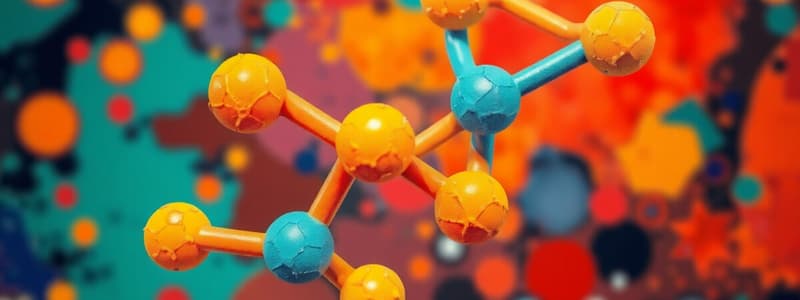Podcast
Questions and Answers
What type of glucose monomer is starch made of?
What type of glucose monomer is starch made of?
- glucose-6-phosphate
- β-glucose
- fructose
- α-glucose (correct)
Which component of starch releases glucose more rapidly for cellular respiration?
Which component of starch releases glucose more rapidly for cellular respiration?
- Glycogen
- Amylose
- Amylopectin (correct)
- Cellulose
What type of glycosidic bonds link the glucose units in amylopectin?
What type of glycosidic bonds link the glucose units in amylopectin?
- 1-4 and 1-6 α-glycosidic bonds (correct)
- 1-6 and 1-7 β-glycosidic bonds
- 1-2 and 1-3 β-glycosidic bonds
- 1-5 and 1-4 α-glycosidic bonds
Glycogen differs from amylopectin in that glycogen is:
Glycogen differs from amylopectin in that glycogen is:
Which of the following best describes the structural function of cellulose?
Which of the following best describes the structural function of cellulose?
What type of bond is formed when a fatty acid combines with glycerol?
What type of bond is formed when a fatty acid combines with glycerol?
Why are lipids insoluble in water?
Why are lipids insoluble in water?
What property of amylose contributes to its compact structure?
What property of amylose contributes to its compact structure?
What is the main role of glycogen in animal cells?
What is the main role of glycogen in animal cells?
Which of the following best describes triglycerides?
Which of the following best describes triglycerides?
What is the molecular structure of glucose in its dry powder form?
What is the molecular structure of glucose in its dry powder form?
Which statement correctly describes the α-glucose structure?
Which statement correctly describes the α-glucose structure?
What is formed as a result of the condensation reaction between monosaccharides?
What is formed as a result of the condensation reaction between monosaccharides?
What type of bond connects monosaccharides in polysaccharides?
What type of bond connects monosaccharides in polysaccharides?
Which effect does the presence of functional groups have on sugars indicating reducing properties?
Which effect does the presence of functional groups have on sugars indicating reducing properties?
What characterizes sucrose in contrast to reducing sugars?
What characterizes sucrose in contrast to reducing sugars?
How can the presence of reducing sugars be detected using Benedict's reagent?
How can the presence of reducing sugars be detected using Benedict's reagent?
What happens to glycosidic bonds during hydrolysis?
What happens to glycosidic bonds during hydrolysis?
What structural feature allows for greater stability in the ring form of glucose?
What structural feature allows for greater stability in the ring form of glucose?
What is a common characteristic of all reducing sugars?
What is a common characteristic of all reducing sugars?
Flashcards are hidden until you start studying
Study Notes
Glucose Structure and Properties
- Composed of 6 carbon, 12 hydrogen, and 6 oxygen atoms (C6H12O6) with a ratio of C:H:O as 1:2:1.
- Contains five hydroxyl groups (-OH), making it highly water soluble and capable of forming hydrogen bonds.
- Exhibits two structural forms: a straight chain when dry and a cyclic ring form (6 membered) when dissolved in water.
- Isomers: two types exist - α-glucose (OH on carbon 1 pointing down) and β-glucose (OH on carbon 1 pointing up).
- Ring structure is more stable in solution, space-efficient, enhancing energy storage and stability in polymer formations like glycogen.
Disaccharides
- Comprise 12 carbons, 22 hydrogens, and 11 oxygens (C12H22O11).
- Formed by the condensation of two monosaccharides through a glycosidic bond.
- Bond formation involves a condensation reaction, resulting in water removal, catalyzed by specific enzymes.
- Glycosidic bond breakage occurs via hydrolysis, adding water and also catalyzed by enzymes.
Testing for Reducing Sugars
- Utilize Benedict’s reagent and heat; a color change from blue to brick red indicates reducing sugars presence.
- Test shows a semi-quantitative result: faster color change or higher intensity of red indicates greater sugar concentration.
- All monosaccharides and disaccharides like maltose and lactose are reducing sugars due to free functional groups.
- Sucrose is non-reducing because its 1-2 glycosidic bond occupies both functional groups.
Polysaccharides
- General formula: (C6H10O5)n; polymers of monosaccharides linked by glycosidic bonds.
- Key roles:
- Starch and glycogen serve as energy storage, compact, inert, and insoluble to not affect cell water potential.
- Glucose can be rapidly released through enzyme-catalyzed reactions.
- Cellulose provides structural strength for cell walls due to high tensile strength.
Starch
- Composed of α-glucose monomers linked by glycosidic bonds.
- Exists as two components:
- Amylose: linear, non-branching chains linked by 1-4 α-glycosidic bonds, forming a compact helical structure.
- Amylopectin: branched structure due to 1-4 and 1-6 α-glycosidic bonds, allowing rapid glucose release.
- Starch accumulates in chloroplasts and storage organs like potatoes.
Glycogen
- Structure consists of α-glucose with both 1-4 and 1-6 glycosidic bonds.
- Highly branched, making it easier for rapid access to stored energy.
- Glycogen granules form in liver and muscle cells, serving as energy reserves.
Dipoles and Hydrogen Bonds
- Dipoles arise from uneven charge distribution in molecules containing -OH, -CO, or -NH groups.
- Hydrogen bonds form between negatively charged atoms (O, N, F) of one molecule and positively charged hydrogen of another.
Lipids
- Organic molecules mainly made of carbon, hydrogen, and lower proportions of oxygen compared to carbohydrates.
- Lack of polar -OH groups renders lipids hydrophobic and insoluble in water.
- Types of lipids include:
- Triglycerides: formed by three fatty acids esterified to glycerol.
- Phospholipids: contain fatty acids combined with glycerol and phosphate groups.
- Steroids and cholesterol: characterized by a distinctive four-ring structure.
Studying That Suits You
Use AI to generate personalized quizzes and flashcards to suit your learning preferences.



